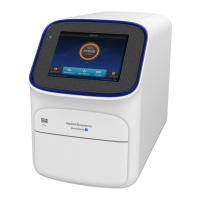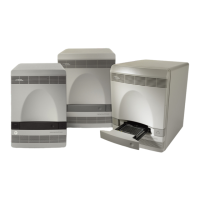Oligonucleotide that anks the 5′ end of the amplicon. The rev
erse primer and the
forward primer are used together in PCR reactions to amplify the target.
Samples having both allele 1 and allele 2.
In the thermal prole, the stage that holds the temperature constant for a dened
period of time.
Samples having only allele 1 or only allele 2.
A software feature that allows you to monitor the status of any instrument on the
network; view calibration, maintenance, and instrument properties for a selected
instrument; and open and close the instrument drawer.
A software feature that allows you to monitor the status of an instrument; monitor
Amplication Plots and temperature plots in real time; view the calibration status,
perform calibrations and manage les on the instrument, including downloading
completed experiments to your computer.
In presence/absence experiments, a short synthetic DNA template that is added to
PCR reactions. The IPC can be used to distinguish between true negative results (the
target is absent in the samples) and negative results caused by PCR inhibitors,
incorrect assay setup, or reagent or instrument failure.
See “internal positive control (IPC)“ on page 187.
See “negative control-IPC wells“ on page 188.
A plot of data collected during the melt curve stage. Peaks in the melt curve can
indicate the melting temperature (T
m
) of the target, or they can identify nonspecic
PCR amplication. In the software, you can view the melt curve as normalized
reporter (R
n
) vs. temperature or as derivative reporter (–R
n
′ ) vs. temperature.
The melt curve shape and the dierence in melting temperature (T
m
) values.
In the thermal prole, a stage with a temperature increment to generate a melt curve.
The temperature at which 50% of the DNA is double-stranded and 50% of the DNA is
dissociated into single-stranded DNA. In a melt curve experiment, the melt curve plot
displays the melting temperature.
In Melt Curve experiments, the region before and after the melting temperature (T
m
).
See also “melting temperature (Tm)“ on page 187.
The task for targets or SNP assays in wells that contain water or buer instead of
sample. No amplication of the target should occur in negative control wells.
Previously called no template control (NTC).
forward primer
heterozygote
holding stage
homozygote
Instrument
Consol
e
Instrument
Manager
internal positive
control (IPC)
IPC
IPC+
melt curve
melt curve
characteristics
melt curve stage
melting
temperature (T
m
)
melting transition
region
negative control
(NC)
Limited product warranty
QuantStudio
™
6 and 7 Flex Real-Time PCR Systems v1.6 Maintenance and Administration Guide
187
